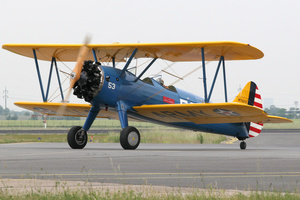Shot-Peening Over Coffee and Pie
by Tony Abbey, FE Training
Firstly, I must make an apology for yet another aviation related blog intro.
On Saturday I was offered, out of the blue, a ride in an open cockpit Stearman biplane from 1942. It has a 220 hp engine, but is quite a heavy plane at just over 2 tons fully loaded. It is also a tail dragger – a small wheel at the rear means it sits, taxies and lands in a nose up attitude.
 It has been over 20 years since I flew anything in anger, so I expected just a very pleasant ride around the area. However, Bob the pilot had other ideas. “She’s all yours”, was the instruction, after the initial take-off. The subsequent “Take her in “as we flew down wind, was even more amazing. After a few circuits and then taxiing back to Bob’s hangar very, very carefully the somewhat wry conclusion was; “well we didn’t scare each other too badly”.
It has been over 20 years since I flew anything in anger, so I expected just a very pleasant ride around the area. However, Bob the pilot had other ideas. “She’s all yours”, was the instruction, after the initial take-off. The subsequent “Take her in “as we flew down wind, was even more amazing. After a few circuits and then taxiing back to Bob’s hangar very, very carefully the somewhat wry conclusion was; “well we didn’t scare each other too badly”.
After that experience it was time to head to Flo’s Café for coffee and pie. You would probably drive straight past Flo’s with a shudder. However, it is the classic hole-in-the-wall spot with the best pie I have ever tasted.Tucking into the pie, I discovered that Bob is not only a superb pilot; he also runs a shot-peening business. For the next hour or so Bob took me through what shot-peening is all about. This was a superb education for me; I knew the theoretical benefits of the process in producing a compressive layer and had blasted away at a component in my apprenticeship. On the NAFEMS fatigue e-learning course my observations are limited to the fact shot-peening is a good thing.
I had never quite understood how any precision or consistency could be achieved in shot peening. Bob explained the calibration techniques used on samples and the quality control used to ensure that the right size of shot and intensity of application is used. Equally fascinating was the difference between glass and steel shot behaviour and the treatment of metals and ceramics.
However, one story that really resonated with me concerned the surface finish of an undercarriage oleo leg with a circumferential oil seal. The supplier was polishing the leg to a high finish, but the fatigue test life was one third of target. Bob suggested that fine grade shot-peening could improve the fatigue life and provide a better surface for the seal to bed into. Tiny dimples from peening would provide reservoirs of oil and so stop the oil film being squeezed out as in a smooth finish. This was rejected initially, but then after some thought Bob was approached to try it out. The fatigue life was exceeded by a big margin! Bob was commissioned to make a special rig to process all the legs in the fleet and it was put to use whilst still on the delivery pallet.
We also talked about problems with sleeve valve piston engines being over polished in modern engine restorations with subsequent breakdown of lubrication seals. The contemporary understanding of the need for a relatively coarser surface finish had been lost.
Afterwards, I was thinking about how we idealize contact in FE analysis. We put a lot of effort into defining perfectly smooth bearing surfaces. Our main problem is to avoid spurious mesh penetrations digging into each contact surface and creating stress hotspots. Analytic contact surfaces use either a spline fit through the mesh or parent geometry to ensure a more realistic smooth surface. But how realistic is a perfectly smooth surface? In practice as any pair of surfaces mate, small protrusions and dimples help to provide a ‘softer’ bearing reaction on first contact. As these features are crushed the reaction force will steadily build. Perhaps we should be using this approach to establish initial contact penalty stiffness.
It also reminded me of previous analyses investigating container impacts on to a perfectly flat, rigid surface. The critical case for deceleration was a flat down impact where every part of the container base met the flat surface instantaneously. Now we knew in practice that this is virtually unachievable, but it was understood this gave a very conservative upper bound. The corresponding critical case for damage was a CG over corner impact orientation.
FE analysis is full of examples where the mathematics of the process diverges from real-world phenomena. Classic examples are right angled corners giving stress singularities, fully built-in structures giving harsh boundary conditions and lack of natural eccentricities causing perfect shapes to refuse to buckle without ‘help’.The conversation with Bob really reminded me how important it is to make sure that as analysts we don’t live in an ivory tower. Keeping in touch with the real world is absolutely essential.
That was a great day!
Until next time,
Regards,
Tony

 It has been over 20 years since I flew anything in anger, so I expected just a very pleasant ride around the area. However, Bob the pilot had other ideas. “She’s all yours”, was the instruction, after the initial take-off. The subsequent “Take her in “as we flew down wind, was even more amazing. After a few circuits and then taxiing back to Bob’s hangar very, very carefully the somewhat wry conclusion was; “well we didn’t scare each other too badly”.
It has been over 20 years since I flew anything in anger, so I expected just a very pleasant ride around the area. However, Bob the pilot had other ideas. “She’s all yours”, was the instruction, after the initial take-off. The subsequent “Take her in “as we flew down wind, was even more amazing. After a few circuits and then taxiing back to Bob’s hangar very, very carefully the somewhat wry conclusion was; “well we didn’t scare each other too badly”.

